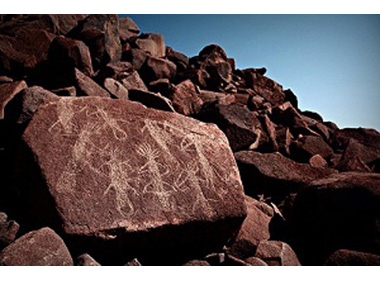UWA Professor Sets Sights on Pilbara Rock Art

Prof McDonald says several Pilbara style provinces have been identified but are yet to be properly studied. Photo: Castillo Rocas
Aboriginal Art Directory | 22.07.12
Author: Geoff Vivian
News source: Science WA
ARCHEOLOGIST Professor Jo McDonald is the inaugural Rio Tinto chair of Rock Art Studies at the University of Western Australia.
She says her main focus will be the study of Pilbara rock art, and directing the Centre for Rock Art Research and Management.
“We are aiming to get a number of research projects working in particular rock art provinces,” she says.
Prof McDonald says several Pilbara style provinces have been identified but are yet to be properly studied.
“We don’t have any quantification of [the] differences that are being observed, so one of the things we are very interested in is getting a better process of inventory.
“It’s a process of documentation and working with the Aboriginal community to record sites that they’re particularly interested in having recorded … and getting a better handle on how old they might be and the sorts of stylistic diversity that occurs [and its relationship] across the Pilbara within their smaller social groups.
She says historical changes meant today’s Aboriginal people were often unfamiliar with the rock art sites that are part of their own heritage.
“There’s less access to country and people don’t have the same sort of mobility they once had in terms of walking everywhere,” she says.
Prof McDonald says the Canning Stock Route project is an example of taking traditional owners back to their ancestral country.
“[We took] about 60 different people, located in … desert communities around the edge of the desert, back out on country and we looked at sites they remember from when they were children or remember their parents talking about,” she says.
“That’s often the first access these groups have had, to going back and looking at sites that a couple of generations ago were part of their daily routine.”
A culturally appropriate interpretation strategy for the Dampier Archipelago will be a priority.
“It gets many visitors [every] year and there’s no signage,” she says.
Prof McDonald says a governance structure, the Marujuga Aboriginal Corporation, has now been formed.
“They will be the group that in fact are managing the works - both as rangers on the ground and also as a circle of elders to make sure that all the work that takes place [is] what the community wants.”
Share this:
»  del.icio.us
»
del.icio.us
»  Digg it
»
Digg it
»  reddit
»
reddit
»  Google
»
Google
»  StumbleUpon
»
StumbleUpon
»  Technorati
»
Technorati
»  Facebook
Facebook
Contact Details
Further Research
News Tags: Archeologist Professor Jo McDonald | Dampier Archipelago | Pilbara Rock Art | Rio | Rio Tinto chair of Rock Art Studies | University of Western Australia | UWA
News Categories: Media
News Archive
- 11.10.17 | RETURN OF MUNGO MAN
- 10.10.17 | TARNANTHI 2017
- 11.08.17 | Natsiaas 2017
- 08.08.17 | ABORIGINAL ART ECONOMICS
- 02.08.17 | SCHOLL'S NEXT MOVE
- 20.07.17 | APY ART DOMINATES THE WYNNE
- 17.07.17 | Anangu Artist Wins $100,000 Prize
- 14.07.17 | The End of AAMU
- 13.07.17 | YOU ARE HERE
- 11.07.17 | ART ACROSS THE COUNTRY
- 11.07.17 | TARNANTHI IN OCTOBER
- 05.07.17 | TJUNGUṈUTJA - from having come together
- 02.07.17 | BENNELONG
- 27.06.17 | JIMMY CHI
- 23.06.17 | Blak Markets at Barangaroo
Advertising

